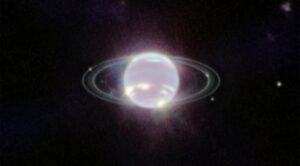Rocket Lab selects NASA Stennis Space Center for Neutron Engine Test Facility
Thursday, 22 September 2022 10:33 Rocket Lab USA, Inc (Nasdaq: RKLB) has selected NASA's historic Stennis Space Center in Mississippi as the location of its engine test facility for its reusable rocket, Neutron.
The Archimedes Test Complex will be located within the larger A Test Complex at Stennis Space Center across a 1 million square foot area for 10 years, with an option to extend the lease for an additional 10 years.
Rocket Lab USA, Inc (Nasdaq: RKLB) has selected NASA's historic Stennis Space Center in Mississippi as the location of its engine test facility for its reusable rocket, Neutron.
The Archimedes Test Complex will be located within the larger A Test Complex at Stennis Space Center across a 1 million square foot area for 10 years, with an option to extend the lease for an additional 10 years. Starburst Ventures launches new Pre-Seed and Seed Fund for Aerospace and Defense
Thursday, 22 September 2022 10:33 Starburst Ventures, the first venture capital fund dedicated to investing across aviation, space, and defense, has announced the launch of its new early-stage fund. Focusing on aerospace, defense, security, as well as enabling sciences and technologies, Starburst Ventures is investing in the next generation of industrial, software and hardware companies.
The fund's team will be led by Star
Starburst Ventures, the first venture capital fund dedicated to investing across aviation, space, and defense, has announced the launch of its new early-stage fund. Focusing on aerospace, defense, security, as well as enabling sciences and technologies, Starburst Ventures is investing in the next generation of industrial, software and hardware companies.
The fund's team will be led by Star Rocket Lab hosts Investor Day in New York
Thursday, 22 September 2022 10:33 Rocket Lab USA, Inc. (Nasdaq: RKLB), a leading launch and space systems company, has hosted an Investor Day and Neutron Development Update at the Intrepid Air, Sea and Space Museum in New York City and streamed the event live on YouTube.
Rocket Lab Founder and Chief Executive Officer Peter Beck, joined by members of the Company's executive leadership team, provided a series of presentation
Rocket Lab USA, Inc. (Nasdaq: RKLB), a leading launch and space systems company, has hosted an Investor Day and Neutron Development Update at the Intrepid Air, Sea and Space Museum in New York City and streamed the event live on YouTube.
Rocket Lab Founder and Chief Executive Officer Peter Beck, joined by members of the Company's executive leadership team, provided a series of presentation NASA says delayed Moon rocket passed fueling test
Thursday, 22 September 2022 10:33 NASA said Wednesday it had successfully trialed the fueling process for its new rocket, after technical issues a few weeks ago halted two attempts to get the behemoth off the ground and headed towards the Moon.
"All of the objectives that we set out to do we were able to accomplish today," said Charlie Blackwell-Thompson, launch director of the program called Artemis 1.
The unmanned miss
NASA said Wednesday it had successfully trialed the fueling process for its new rocket, after technical issues a few weeks ago halted two attempts to get the behemoth off the ground and headed towards the Moon.
"All of the objectives that we set out to do we were able to accomplish today," said Charlie Blackwell-Thompson, launch director of the program called Artemis 1.
The unmanned miss Artemis Cryogenic Demonstration test concludes, all objectives met
Thursday, 22 September 2022 10:33 The launch director has confirmed all objectives have been met for the cryogenic demonstration test, and teams are now proceeding with critical safing activities and preparations for draining the rocket's tanks. After encountering a hydrogen leak early in the loading process, engineers were able to troubleshoot the issue and proceed with the planned activities.
The four main objectives for
The launch director has confirmed all objectives have been met for the cryogenic demonstration test, and teams are now proceeding with critical safing activities and preparations for draining the rocket's tanks. After encountering a hydrogen leak early in the loading process, engineers were able to troubleshoot the issue and proceed with the planned activities.
The four main objectives for Shenzhou XIV astronauts in 4-hour spacewalk
Thursday, 22 September 2022 10:33 Chinese astronauts on the Shenzhou XIV mission completed their second spacewalk on Saturday afternoon, according to the China Manned Space Agency.
Senior Colonel Cai Xuzhe opened an extravehicular hatch on the Tiangong space station at 1:35 pm and stepped into space. He was followed by mission commander Senior Colonel Chen Dong, the agency said.
Senior Colonel Liu Yang, the female cr
Chinese astronauts on the Shenzhou XIV mission completed their second spacewalk on Saturday afternoon, according to the China Manned Space Agency.
Senior Colonel Cai Xuzhe opened an extravehicular hatch on the Tiangong space station at 1:35 pm and stepped into space. He was followed by mission commander Senior Colonel Chen Dong, the agency said.
Senior Colonel Liu Yang, the female cr Space missions bring Down-to-Earth benefits
Thursday, 22 September 2022 10:33 Spectacle of rocket launches draws throngs of visitors, newfound prosperity to township in coastal Hainan
Editor's note: In this series, China Daily looks at some of the areas in which major progress has been made in the 10 years since the 18th National Congress of the Communist Party of China was held in November 2012.
Chen Li, a 62-year-old restaurant owner in Longlou, a coastal to
Spectacle of rocket launches draws throngs of visitors, newfound prosperity to township in coastal Hainan
Editor's note: In this series, China Daily looks at some of the areas in which major progress has been made in the 10 years since the 18th National Congress of the Communist Party of China was held in November 2012.
Chen Li, a 62-year-old restaurant owner in Longlou, a coastal to Arianespace signs agreement with SAB-LS for the provision of cubesat services
Thursday, 22 September 2022 10:33 Arianespace has announced during the International Astronautical Congress, the signature of a multi-year framework agreement. The contract entrusts SAB-LS to co-operate as partner of Arianespace for the provision of end-to-end services for nanosatellites wishing to fly on Arianespace missions.
The agreement is specific to the supply of hardware, mission preparation and integration services
Arianespace has announced during the International Astronautical Congress, the signature of a multi-year framework agreement. The contract entrusts SAB-LS to co-operate as partner of Arianespace for the provision of end-to-end services for nanosatellites wishing to fly on Arianespace missions.
The agreement is specific to the supply of hardware, mission preparation and integration services Gilmour Space announces first 'Caravan' rideshare mission to LEO
Thursday, 22 September 2022 10:33 Australian launch services company, Gilmour Space Technologies, has announced that it will launch a dedicated rideshare mission into low earth orbit (LEO) in late 2024.
Unlike most rocket launches which host a primary customer payload, a rideshare launch comprises of many customer payloads such as cubesats, microsats and other small spacecraft.
"Called Caravan-1, this mission will pr
Australian launch services company, Gilmour Space Technologies, has announced that it will launch a dedicated rideshare mission into low earth orbit (LEO) in late 2024.
Unlike most rocket launches which host a primary customer payload, a rideshare launch comprises of many customer payloads such as cubesats, microsats and other small spacecraft.
"Called Caravan-1, this mission will pr Axiom Space and Turkey sign agreement to send first Turkish astronaut to space
Thursday, 22 September 2022 10:33 Commercial space leader Axiom Space and the government of Turkiye have signed a historic agreement to send the first Turkish astronaut to space. As part of a larger effort by Turkiye to expand its space exploration capabilities and establish a national human space program, a Turkish astronaut will be trained by Axiom Space for a future space research mission. Axiom Space will also enable Turkish
Commercial space leader Axiom Space and the government of Turkiye have signed a historic agreement to send the first Turkish astronaut to space. As part of a larger effort by Turkiye to expand its space exploration capabilities and establish a national human space program, a Turkish astronaut will be trained by Axiom Space for a future space research mission. Axiom Space will also enable Turkish Rocket Lab to launch NOAA-supported Argos-4 Spacecraft for General Atomics
Thursday, 22 September 2022 10:33 Rocket Lab USA, Inc (Nasdaq: RKLB) reports it will launch a dedicated Electron mission for General Atomics Electromagnetic Systems (GA-EMS). Electron is scheduled to launch the "It Argos Up From Here" mission from Rocket Lab Launch Complex 1 in Mahia, New Zealand during a launch window that opens October 5 UTC.
The "It Argos Up From Here" mission will launch the GA-EMS designed and manufac
Rocket Lab USA, Inc (Nasdaq: RKLB) reports it will launch a dedicated Electron mission for General Atomics Electromagnetic Systems (GA-EMS). Electron is scheduled to launch the "It Argos Up From Here" mission from Rocket Lab Launch Complex 1 in Mahia, New Zealand during a launch window that opens October 5 UTC.
The "It Argos Up From Here" mission will launch the GA-EMS designed and manufac Viasat and Inmarsat receive UK Govt approval for proposed merger
Thursday, 22 September 2022 10:33 Viasat Inc., (NASDAQ: VSAT), a global communications company, and Inmarsat, a leading provider of global mobile satellite communications services, has announced the receipt of approval of the proposed combination of their businesses by the UK Government under the National Security and Investment Act.
The Secretary of State for Business, Energy and Industrial Strategy (BEIS) has announced t
Viasat Inc., (NASDAQ: VSAT), a global communications company, and Inmarsat, a leading provider of global mobile satellite communications services, has announced the receipt of approval of the proposed combination of their businesses by the UK Government under the National Security and Investment Act.
The Secretary of State for Business, Energy and Industrial Strategy (BEIS) has announced t Mediterranean Sea hit by marine heatwave
Thursday, 22 September 2022 10:20
Many parts of Europe saw record-breaking temperatures over the summer, but it wasn’t just the continental mainland that was affected: the Mediterranean Sea also suffered a major marine heatwave. An ESA-funded project, CAREHeat, detected one of the most intense Mediterranean marine heatwaves observed during the satellite era – with sea surface temperatures reaching 5°C higher than average.
NASA studying issue with JWST instrument
Thursday, 22 September 2022 08:45
One part of an instrument on the James Webb Space Telescope is out of service temporarily, although project officials are confident it will not be a long-term problem.
The post NASA studying issue with JWST instrument appeared first on SpaceNews.
ESA announces winning startups at IAC event
Thursday, 22 September 2022 08:30
ESA continues to lead the way and create opportunities for talented entrepreneurs. This week it announced the winners of its start-up competition at the 73rd International Astronautical Congress (IAC 2022) in Paris.

